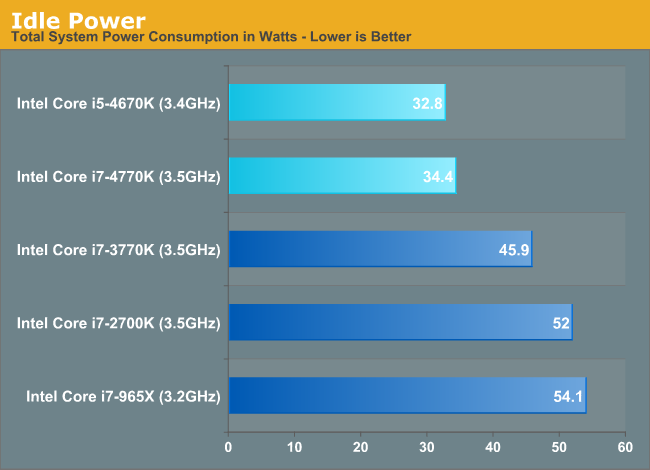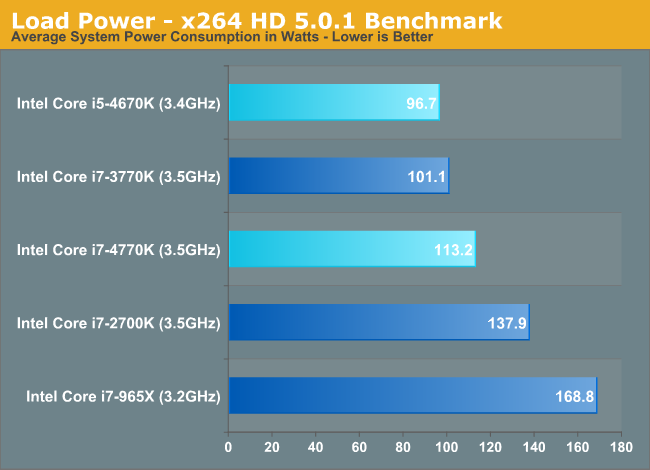The Haswell Review: Intel Core i7-4770K & i5-4670K Tested
by Anand Lal Shimpi on June 1, 2013 10:00 AM ESTPower Improvements
Although Haswell’s platform power is expected to drop considerably in mobile, particularly with Haswell U and Y SKUs (Ultrabooks and ultrathins/tablets), there are benefits to desktop Haswell parts as well.
There’s more fine grained power gating, lower chipset power and the CPU cores can transition between power states about 25% quicker than in Ivy Bridge - allowing the power control unit to be more aggressive in selecting lower power modes. We’ve also seen considerable improvements on lowering platform power consumption at the motherboard level as well. Using ASUS’ Z77 Deluxe and Z87 Deluxe motherboards for the Haswell, Ivy and Sandy Bridge CPUs, I measured significant improvements in idle power consumption:

These savings are beyond what I’d expect from Haswell alone. Intel isn’t the only one looking to make things as best as can be in the absence of any low hanging fruit. The motherboard makers are aggressively polishing their designs in order to grow their marketshare in a very difficult environment.
Under load, there’s no escaping the fact that Haswell can burn more power in pursuit of higher performance:

Here I’m showing an 11.8% increase in power consumption, and in this particular test the Core i7-4770K is 13% faster than the i7-3770K. Power consumption goes up, but so does performance per watt.
The other big part of the Haswell power story is what Intel is calling FIVR: Haswell’s Fully Integrated Voltage Regulator. Through a combination of on-die and on-package circuitry (mostly inductors on-package), Haswell assumes responsibility of distributing voltages to individual blocks and controllers (e.g. PCIe controller, memory controller, processor graphics, etc...). With FIVR, it’s easy to implement tons of voltage rails - which is why Intel doubled the number of internal voltage rails. With more independent voltage rails, there’s more fine grained control over the power delivered to various blocks of Haswell.
Thanks to a relatively high input voltage (on the order of 1.8V), it’s possible to generate quite a bit of current on-package and efficiently distribute power to all areas of the chip. Voltage ramps are 5 - 10x quicker with FIVR than with a traditional on-board voltage regulator implementation.
In order to ensure broad compatibility with memory types, there’s a second input voltage for DRAM as well.
FIVR also comes with a reduction in board area and component cost. I don’t suppose this is going to be a huge deal for desktops (admittedly the space and cost savings are basically non-existent), but it’ll mean a lot for mobile.
No S0ix for Desktop
You’ll notice that I didn’t mention any of the aggressive platform power optimizations in my sections on Haswell power management, that’s because they pretty much don’t apply here. The new active idle (S0ix) states are not supported by any of the desktop SKUs. It’s only the forthcoming Y and U series parts that support S0ix.










210 Comments
View All Comments
CajunArson - Saturday, June 1, 2013 - link
Great review, but I have a question about this rather cryptic comment for bclk overclocking:"All CPUs are frequency locked, however K-series parts ship fully unlocked. A new addition is the ability to adjust BCLK to one of three pre-defined straps (100/125/167MHz). The BCLK adjustment gives you a little more flexibility when overclocking, but you still need a K-SKU to take advantage of the options."
Does that mean you cannot do bclk overclocking on the non-K series parts? For example, are you saying that a 4770 (non-K) part cannot be used with a bclk overclock? Or are you just saying that the K-series parts give you all the options including unlocked multipliers? Can you clarify this?
Rajinder Gill - Saturday, June 1, 2013 - link
All you can do on the non K parts is 100 bclk +- 5%.smilingcrow - Saturday, June 1, 2013 - link
It doesn't seem cryptic to me!kasakka - Saturday, June 1, 2013 - link
Too bad there are no temperature comparisons. Would be interesting to see if Intel has improved the TIM under the heatspreader.That said, now I'm glad I didn't wait for Haswell as it doesn't seem to have much to give over Ivy unless you use the intergrated GPU.
A5 - Saturday, June 1, 2013 - link
Other reviews have it as notably hotter under load, fwiw. Probably due to the voltage regulators.HisDivineOrder - Saturday, June 1, 2013 - link
Now that AMD has mostly fallen back to the mid-range and low-end, this is a similar situation to where the new Geforces landed.You get a bit more performance for about the same money. For the GPU side, the benefit was mostly in superior cooling solutions all (supposedly) having to be equivalent to the excellent Titan Blower. For the CPU side, the benefit is that we have lower idles. These chips stay in idle a lot, so it's a gain, but this isn't a chip that's going to light the hobbyist world on fire.
Just like with the GF770, you get more performance and a few fringe benefits (that should have been there all along, ie., 6 SATA3 connections) for the same as you would have paid for the equivalent part last week.
I don't see much here to make me want to upgrade from my IVB 3750k, though. I'm leaning toward picking up a used GF670 and SLI'ing now, given all the givens.
The truly disappointing part of all this is if this is truly the last new desktop release for two years. Imagine me going 3+ years before I even FEEL an itch to upgrade my processor. I sincerely pray that AMD gets its act together and puts some competitive pressure on Intel at the mid-high end (ie., 2500k, 3570k) with a truly great CPU. I live in hope that the 8350 successor (based on Steamroller?) will be that part, but AMD needs to update their chipsets big time.
Until then, I think all we can expect from Intel and nVidia is more of the same, which is the worst part of both the 700 series and Haswell. Neither felt compelled to do more than offer minor improvements in performance because neither is feeling any competitive pressure of any kind.
That's why Intel IS pushing the power argument and fighting that fight hard. Because ARM *is* applying competitive pressure.
Hector2 - Saturday, June 1, 2013 - link
Even without competition, Intel is still by economics to keep pushing transistor sizes and die sizes smaller and smaller --- it still lowers their costs and they make more money. This also means they keep getting faster and require less and less power. What competition does, besides lower prices, is drive architectural changes that add more die size (like an integrated GPU and FIVR)JDG1980 - Saturday, June 1, 2013 - link
Keep in mind that an increasing percentage of desktop/laptop PCs are now in the business world (since light-use consumers have often moved towards tablets and smartphones). If you're doing office work, then lower power use on idle/light load is a big deal. Office PCs almost never run balls-to-the-wall. In fact, usually the only time the CPU even comes close to being completely pegged is when the mandatory virus scan runs (and even then, it's often HDD-bound).leliel - Saturday, June 1, 2013 - link
I'm still on a Lynnfield 750 (as are a few other commenters, I note) and this system is now 3.5 years old without me having had the itch to upgrade or even overclock the CPU. I have been eyeing Haswell because I know I will be making a fresh build at the end of the year, but that's due to circumstance and not need. 30% clock increase in four years is nothing like the old days... but frankly it's nice to be able to keep up in everything just by swapping out video cards.Klimax - Sunday, June 2, 2013 - link
I doubt we will see large increases in future. We need new algorithms. (Current ones are the limit) Why? Because major performance increases would require significant increase in complexity and GPU showed what that causes.And AMD won't and cannot change it.